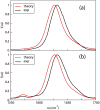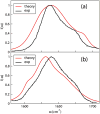Development and validation of transferable amide I vibrational frequency maps for peptides
- PMID: 21405034
- PMCID: PMC3274961
- DOI: 10.1021/jp200745r
Development and validation of transferable amide I vibrational frequency maps for peptides
Abstract
Infrared (IR) spectroscopy of the amide I band has been widely utilized for the analysis of peptides and proteins. Theoretical modeling of IR spectra of proteins requires an accurate and efficient description of the amide I frequencies. In this paper, amide I frequency maps for protein backbone and side chain groups are developed from experimental spectra and vibrational lifetimes of N-methylacetamide and acetamide in different solvents. The frequency maps, along with established nearest-neighbor frequency shift and coupling schemes, are then applied to a variety of peptides in aqueous solution and reproduce experimental spectra well. The frequency maps are designed to be transferable to different environments; therefore, they can be used for heterogeneous systems, such as membrane proteins.
Figures













Similar articles
-
Molecular mechanics force field-based general map for the solvation effect on amide I probe of peptide in different micro-environments.Spectrochim Acta A Mol Biomol Spectrosc. 2014 Jan 3;117:548-56. doi: 10.1016/j.saa.2013.08.058. Epub 2013 Aug 27. Spectrochim Acta A Mol Biomol Spectrosc. 2014. PMID: 24036186
-
Infrared and vibrational CD spectra of partially solvated alpha-helices: DFT-based simulations with explicit solvent.J Phys Chem B. 2007 Feb 22;111(7):1834-45. doi: 10.1021/jp0666840. Epub 2007 Jan 26. J Phys Chem B. 2007. PMID: 17256894
-
Electrostatic frequency maps for amide-I mode of β-peptide: Comparison of molecular mechanics force field and DFT calculations.Spectrochim Acta A Mol Biomol Spectrosc. 2017 Aug 5;183:150-157. doi: 10.1016/j.saa.2017.04.022. Epub 2017 Apr 19. Spectrochim Acta A Mol Biomol Spectrosc. 2017. PMID: 28448953
-
Empirical amide I vibrational frequency map: application to 2D-IR line shapes for isotope-edited membrane peptide bundles.J Phys Chem B. 2009 Jan 22;113(3):592-602. doi: 10.1021/jp807528q. J Phys Chem B. 2009. PMID: 19053670 Free PMC article. Review.
-
Using 2D-IR Spectroscopy to Measure the Structure, Dynamics, and Intermolecular Interactions of Proteins in H2O.Acc Chem Res. 2024 Mar 5;57(5):685-692. doi: 10.1021/acs.accounts.3c00682. Epub 2024 Feb 16. Acc Chem Res. 2024. PMID: 38364823 Free PMC article. Review.
Cited by
-
Refining Disordered Peptide Ensembles with Computational Amide I Spectroscopy: Application to Elastin-Like Peptides.J Phys Chem B. 2016 Nov 10;120(44):11395-11404. doi: 10.1021/acs.jpcb.6b08678. Epub 2016 Oct 27. J Phys Chem B. 2016. PMID: 27736076 Free PMC article.
-
Engineering Proteins at Interfaces: From Complementary Characterization to Material Surfaces with Designed Functions.Angew Chem Int Ed Engl. 2018 Sep 24;57(39):12626-12648. doi: 10.1002/anie.201712448. Epub 2018 Aug 30. Angew Chem Int Ed Engl. 2018. PMID: 29663610 Free PMC article. Review.
-
Vibrational exciton delocalization precludes the use of infrared intensities as proxies for surfactant accumulation on aqueous surfaces.Chem Sci. 2021 May 18;12(24):8320-8332. doi: 10.1039/d1sc01276b. Chem Sci. 2021. PMID: 34221313 Free PMC article.
-
Computational IR Spectroscopy of Insulin Dimer Structure and Conformational Heterogeneity.J Phys Chem B. 2021 May 13;125(18):4620-4633. doi: 10.1021/acs.jpcb.1c00399. Epub 2021 Apr 30. J Phys Chem B. 2021. PMID: 33929849 Free PMC article.
-
Two-Dimensional Vibrational Spectroscopy of a Dissipative System with the Optimized Mean-Trajectory Approximation.J Phys Chem B. 2015 Jul 23;119(29):8950-9. doi: 10.1021/jp5076884. Epub 2014 Oct 2. J Phys Chem B. 2015. PMID: 25275943 Free PMC article.
References
-
- Dickerson RE, Geis I. The structure and action of proteins. W. A. Benjamin, Inc; Menlo Park, CA: 1969.
-
- Nelson DL, Cox MM. Lehninger Principles of Biochemistry. W. H. Freeman and Company; New York: 2005.
-
- Berg JM, Tymoczko JL, Stryer L. Biochemistry. W. H. Freeman and Company; New York: 2007.
-
- McCammon JA, Harvey SC. Dynamics of Proteins and Nucleic Acids. Cambridge University Press; Cambridge: 1987.
-
- Boehr DD, Dyson HJ, Wright PE. Chem Rev. 2006;106:3055. - PubMed
Publication types
MeSH terms
Substances
Grants and funding
LinkOut - more resources
Full Text Sources

